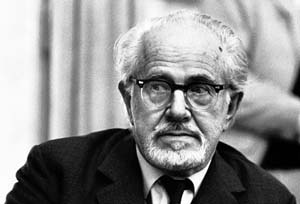The Tigers Eye 1, Mark Tobey, 1952; as quoted in Abstract Expressionist Painting in America, W.C, Seitz, Cambridge Massachusetts, 1983, p. 103
1950's
Famous Mark Tobey Quotes
“I have sought a unified world in my work and use a movable vortex to achieve it.”
as quoted in Abstract Expressionism, Barbara Hess, Taschen, Köln, 2006, p. 60
posthumous Quotes
Source: 1950's, In: Reminiscence and Reverie, 1951, p. 66
“We look at the mountain to see the painting, then we look at the painting to see the mountain.”
Source: 1950's, In: Reminiscence and Reverie, 1951, p. 231
“Reality must be expressed by a physical symbol.”
Bahai lecture, New York, October 30, 1951; as quoted in Abstract Expressionist Painting in America, W.C, Seitz, Cambridge Massachusetts, 1983, p. 10
1950's
“I have many ideas for lights. I will paint only lights at night. [on the twinkling city-lights]”
Quote from Tobey's letter to the cubist painter Feininger, 1955
1950's
Mark Tobey Quotes about the world
Quote from Tobey's Bahai lecture, 1951; as quoted in Abstract Expressionist Painting in America, W.C, Seitz, Cambridge Massachusetts, 1983, pp. 66/67
1950's
Modern Artists in America, R. Motherwell, A. Reinhardt and B. Karpel, First series, New York 1952, p. 28
1950's
Source: 1950's, In: Reminiscence and Reverie, 1951, pp. 45, 46
as quoted in Abstract Expressionism, Barbara Hess, Taschen, Köln, 2006, p. 60
posthumous Quotes
Quote from Fourteen Americans, Mark Tobey, exhibition catalogue MOMA New York, 1946, p. 70
1940's
Mark Tobey Quotes
As quoted in Willem de Kooning, MOMA Bull, pp. 7, 6
1950's
Reminiscence and Reverie, Mark Tobey, Magazine of Art, 44, (October 1951) pp. 230
1950's
Tobey's quote from an exhibition catalogue, Palace of the Legion of Honor, 1951; as quoted in Abstract Expressionist Painting in America, W.C, Seitz, Cambridge Massachusetts, 1983, p. 46
1950's
“We have tried to fit man into abstraction, but he does not fit.”
Statement in his Bahai lecture, Oct 30, 1951, as quoted in Abstract Expressionist Painting in America, W.C, Seitz, Cambridge Massachusetts, 1983, p. 104
1950's
Source: 1950's, In: Reminiscence and Reverie, 1951, p. 230
“Every artist's problem today is: What will we do with the human?”
Quote from exhibition catalogue, Mark Tobey, 1951, as cited in Abstract Expressionist Painting in America, W.C, Seitz, Cambridge Massachusetts, 1983, p.13
1950's
Mark Tobey Retrospective Exhibition, New York, Whitney Museum, 1951
1950's
A Tobey Profile, quoted by Belle Krasne, Art Digest, 26 Oct. 15, 1951
1950's
quote from conversation with Seitz
1950's
Source: 'Reminiscence and Reverie', Mark Tobey, Magazine of Art, 44, October 1951, pp. 228, 231
Abstract Expressionist Painting in America, W.C, Seitz, Cambridge Massachusetts, 1983, p. 39: Statement concerning his painting 'Threading Light'
1950's
